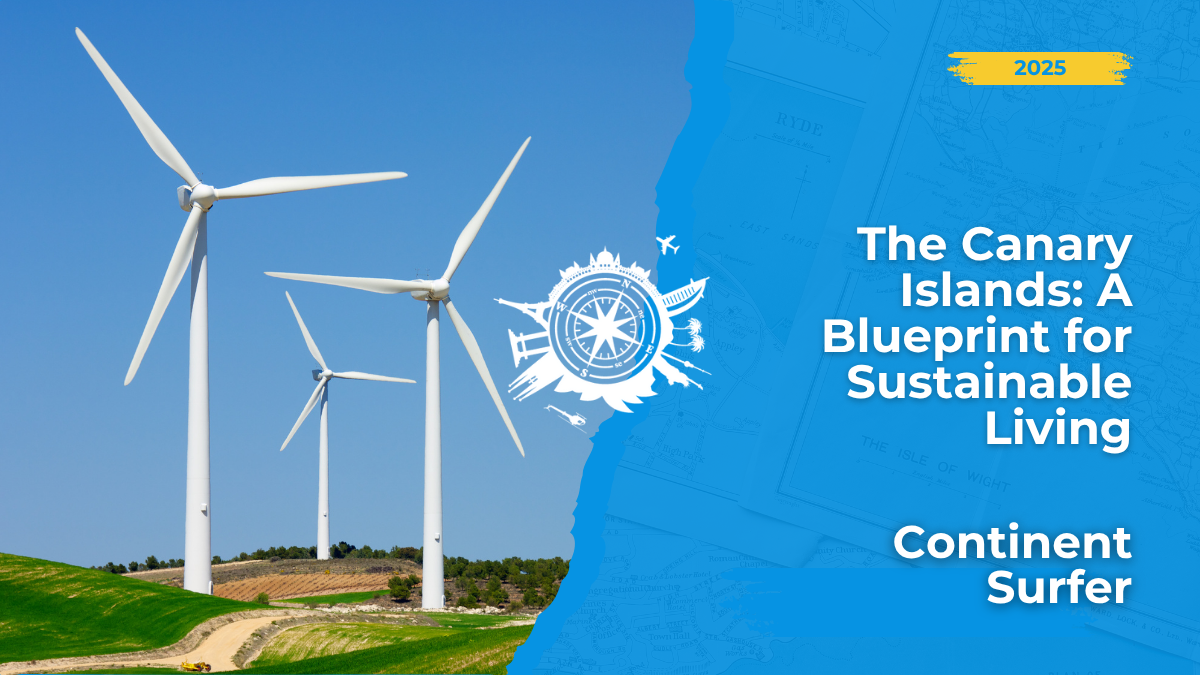The Canary Islands: A Blueprint for Sustainable Living
When considering a move abroad, many factors come to mind: climate, standard of living, opportunities. But have you ever thought about renewable energy sources and sustainability as key decision-makers? Living in a place where you’re not dependent on fossil fuels, where drinking water is clean, and where humans and nature coexist in harmony – this isn’t a utopia anymore; it’s a reality.
written by: Sylvi Lipp – Continent Surfer
The Canary Islands have been at the forefront of sustainability and renewable energy for years. The projects underway here not only protect the environment but also ensure the long-term well-being of local communities and tourism. Renewable energy sources are playing an increasingly significant role, while water management development is also a central theme. The active participation of local residents in these initiatives strengthens community cohesion and promotes sustainable development.
While the islands still rely significantly on fossil fuels, increasing investments are targeting a greater utilisation of solar and wind energy. Let’s explore how individual islands are progressing!
Gran Canaria: Water, Energy, and Sustainability
Gran Canaria has launched several major projects in renewable energy and water management. One of the most exciting developments is the construction of a new pumped-hydro power plant, which allows for the efficient storage of solar and wind energy. The system works by pumping water to a higher reservoir when surplus green energy is available. When energy is needed, the water is released, generating electricity through turbines.
In addition to ocean-side wind turbines and vast solar parks, the island secures its drinking water through desalination plants, as it has scarce natural freshwater reserves. This presents a significant challenge for both residents and tourists. The capital, Las Palmas de Gran Canaria, plans to invest €900 million in modernising its water services, including the construction of a new desalination plant and a wastewater treatment facility. These developments aim to help residents leave a progressively smaller ecological footprint.
Gran Canaria’s desalination plants produce over 140,000 cubic meters of drinking water daily, supplying nearly half of the population.


El Hierro: A Pioneer in Renewable Energy
The smallest Canary Island is a prime example of progress towards sustainability. Its goal is to operate entirely on renewable energy. Central to this is the Gorona del Viento power plant, which boasts five wind turbines, each with a capacity of 2.3 megawatts, totalling 11.5 megawatts. This system uses surplus wind energy to pump water into an upper reservoir, then later releases it through turbines to provide a continuous energy supply.
Since its launch in 2015, the island has operated for over 10,000 hours exclusively on renewable energy – a monumental achievement! Furthermore, organic farming, biodiversity conservation, and sustainable ocean management also play a prominent role. It’s no coincidence that El Hierro has been designated a UNESCO Biosphere Reserve and a global geopark. Here, sustainability isn’t just theory; it’s a part of daily life.


Tenerife: Solar Energy and Ecotourism
Tenerife’s geographical location is perfect for harnessing solar energy, as it receives abundant sunshine hours annually. Consequently, numerous solar energy projects have been launched on the island, aiming to reduce dependence on fossil fuels. More and more residential buildings, public buildings, and industrial facilities are being equipped with solar panel systems, and solar-powered water heaters are becoming increasingly widespread.
Tenerife is home to one of Spain’s largest solar power plants, the Arico photovoltaic park, which supplies energy to over 16,000 households.


Sustainable Tourism in Tenerife
The island’s objective is to minimise the ecological footprint of tourists while ensuring that tourism revenue sustainably strengthens the local community. This includes protecting natural areas, preserving local cultural heritage, and developing environmentally friendly transportation options and accommodations. All of this not only serves to protect the environment but also makes Tenerife even more attractive to those seeking responsible and sustainable travel experiences.
Lanzarote: Sustainable Architecture and Agriculture
Lanzarote is renowned for its sustainable agricultural programs and water conservation techniques, which minimise water usage and support local food production. Volcanic ash helps retain water, so vineyards and other agricultural solutions have adapted to the unique conditions. For example, grapevines are grown in crescent-shaped depressions to capture minimal rainfall and morning dew.
Architect and environmentalist César Manrique had a tremendous impact on the island’s sustainability efforts, advocating for adherence to nature conservation regulations and the harmonious development of the built environment.


Fuerteventura: Wind Energy and Sustainable Tourism
Fuerteventura places a particularly strong emphasis on harnessing and utilising wind energy, as well as on sustainable tourism. UNESCO declared it a Biosphere Reserve in 2009, which aids in achieving sustainability goals. Increasingly, eco-hotels and sustainable surf schools operate on the island, focusing on nature conservation and a low ecological footprint. The island also concentrates on sustainable fishing to preserve its marine ecosystem.
Fuerteventura’s wind farm prevents the emission of over 30,000 tons of carbon dioxide annually, equivalent to the annual emissions of more than 15,000 cars.


Are Sustainability and Tourism Compatible?
The Canary Islands attract millions annually, but increasing energy and water consumption present significant challenges. Can a popular tourist destination become completely sustainable? El Hierro’s example suggests yes – but can the larger islands follow this path?
More and more people are choosing this region not only for its pleasant climate but also for its environmentally conscious lifestyle.
But why is it beneficial to live in a sustainable environment?
- Local energy production reduces dependence on external factors, making residents less affected by price increases.
- Clean energy and eco-friendly systems contribute to a healthier life.
- Sustainable development ensures these places remain liveable for future generations.
The example of the Canary Islands clearly demonstrates that sustainability and modern living are not mutually exclusive. As the world increasingly turns towards renewable energy sources, these islands show the way for those who not only wish to enjoy a beautiful environment but also contribute to its preservation. If you were to move abroad, how much would a place’s sustainability efforts influence your decision?
Did You Know?
The Canary Islands aim to operate entirely on renewable energy by 2040. As part of this ambitious plan, more and more solar, wind, and hydro-based power plants are being built, while dependence on fossil fuels is being reduced.

Like what we do?
If so, please support us, every little counts and is much appreciated!
You will help us to come up with useful information regularly, so please support us every once and a while or even monthly! Thank you!
Source(s):
Join the Continent Surfer community!
Subscribe to our newsletter and be the first to receive the latest news, useful tips, and exclusive offers!
Comment

